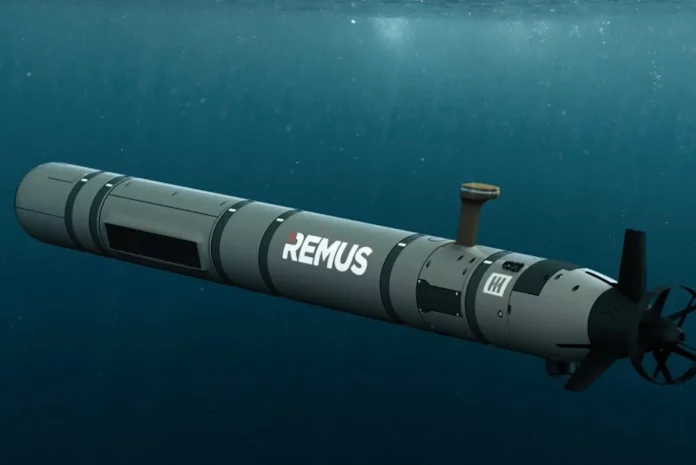Japan aims to bolster its underwater warfare capabilities around the strategic Nansei Islands vis-a-vis China through the acquisition of new unmanned underwater vehicles (UUVs) and partnering with Australia for such technologies.
This month, the Asian Military Review reported that the Japan Maritime Self-Defense Force (JMSDF) plans to enhance its ocean observation capabilities with new UUVs and long-range underwater acoustic communication systems.
The report mentions that the JMSDF has signed contracts for Type I and Type II underwater gliders to perform oceanographic surveys on water temperature, salinity and currents.
It also states that the JMSDF has contracted with local electronics company NEC to develop the Long Distance Underwater Acoustic Communication Module for UUV control, positional awareness and underwater ship communication.
Asian Military Review says that performance tests of the system will start in 2025. NEC demonstrated stable two-way, long-distance communication using an experimental UUV equipped with an early example of the acoustic communication module.
The JMSDF uses the Mitsubishi Heavy Industries OZZ-5 UUV, fitted with a dual-imaging sonar suite, to detect buried objects at low frequencies and perform high-resolution scans of exposed objects on the seabed.
Alongside the OZZ-5 UUV, the Asia Military Review report says the JMSDF also operates the Hydroid REMUS 600 Autonomous Underwater Vehicle (AUV) for use in Mine Countermeasures (MCM) operations.
Meanwhile, Janes reported last month that Japan and Australia have signed a bilateral agreement to co-develop robotics and autonomous systems (RAS) for undersea warfare. Janes says the deal aims to enhance the two nations’ underwater communication technologies and interoperability.
Australia’s Defense Science and Technology Group (DSTG) and Japan’s Acquisition, Technology & Logistics Agency (ATLA) will establish evaluation indices for underwater acoustic communications using test and evaluation simulators and simulations.
The Janes report says that the results of this project are expected to be used for the future interoperability of unmanned underwater vehicles (UUVs) between Japan and Australia.
It says that the first joint research project on underwater communication technologies is expected to be completed by the end of 2027, with research and development activities taking place in Japan and Australia at ATLA and DSTG facilities.
Japan may use its UUVs for mine warfare and anti-submarine operations around the Nansei Islands, which straddle the Miyako Strait, a critical maritime chokepoint for China in the event of an invasion of Taiwan and its submarine-based nuclear arsenal.
The Miyako Strait has seen repeated incursions by People’s Liberation Army-Navy (PLA-N) warships attempting to break out from the First Island Chain consisting of Japan, Taiwan and the Philippines into the Pacific Ocean, ostensibly to perform a flanking maneuver against Taiwan and cut the self-governing island from US reinforcements.
China’s nuclear ballistic missile submarines (SSBN) armed with the older JL-2 submarine-launched ballistic missile (SLBM) may have to reach open waters of the Pacific to bring Guam, Hawaii and the mainland US within strike range, with the Miyako Strait alongside the Bashi Channel being potential submarine routes.
In a paper presented during the 2019 IEEE International Conference on Unmanned Systems, Zhiyun Zhao and other writers detail how UUVs can be used in anti-submarine operations.
Zhao and others describe UUVs’ unique operational characteristics including low acoustic, magnetic, electrical and other signatures. They note that UUVs feature better concealability than manned submarines, enabling them to replace the latter in performing operations in hard-to-reach zones or areas too dangerous for manned craft.
They note that UUVs combine high endurance and autonomy, enabling them to patrol independently predetermined sea areas and guide or coordinate with manned platforms to carry out offensive anti-submarine operations.
They also state that UUVs can fill in anti-submarine warfare capability gaps such as poor sensor performance in shallow waters and limited detection range of fixed underwater sonar systems.
However, Zhao and other writers point out the limitations of UUVs in anti-submarine warfare, stating that the vast areas involved and the duration of such operations mean that UUVs must often be used in clusters. They note the relatively short sensor ranges and low speed of individual UUVs require coordinated and centralized employment.
They also point out the complexity of command and control (C2) systems needed to employ UUVs effectively, stating that multiple communication means with UUVs, such as satellite and data links, are required to attack sensitive targets such as nuclear submarines.


